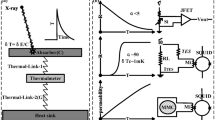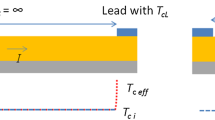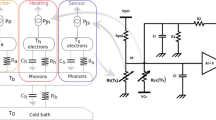Abstract
Optical transition edge sensors (TESs) are characterized by a very fast response, of the order of \(\upmu \)s, which is \(10^3\) times faster than TESs for X-ray and gamma-ray. To extract important parameters associated with the optical TES, complex impedances at high frequencies (> 1 MHz) need to be measured, where the parasitic impedance in the circuit and reflections of electrical signals due to discontinuities in the characteristic impedance of the readout circuits become significant. This prevents the measurements of the current sensitivity \(\beta \), which can be extracted from the complex impedance. In usual setups, it is hard to build a circuit model taking into account the parasitic impedances and reflections. In this study, we present an alternative method to estimate a transfer function without investigating the details of the entire circuit. Based on this method, the complex impedance up to 30 MHz was measured. The parameters were extracted from the impedance and were compared with other measurements. Using these parameters, we calculated the theoretical limit on an energy resolution and compared it with the measured energy resolution. In this paper, the reasons for the deviation of the measured value from theoretically predicted values will be discussed.





Similar content being viewed by others
References
D. Fukuda et al., Opt. Express 19, 870 (2011)
A.E. Lita et al., Opt. Express 16, 3032 (2008)
L. Lolli et al., Appl. Phys. Lett. 103, 041107 (2013)
K. Niwa et al., Sci. Rep. 7, 45660 (2017)
E. Taralli et al., Supercond. Sci. Technol. 23, 105012 (2010)
E. Taralli et al., 2013 IEEE 14th International Superconductive Electronics Conference (ISEC) (2013). https://doi.org/10.1109/ISEC.2013.6604291
K.M. Kinnunen, M.R.J. Palosaari, I.J. Maasilta, J. Appl. Phys. 112, 034515 (2012)
K.D. Irwin, G.C. Hilton, Cryogenic particle detection. Top. Appl. Phys. 99, 63 (2005)
I.J. Maasilta, AIP Adv. 2, 042110 (2012)
K. Kinnunen, Ph.D. thesis, The University of Jyväskylä (2011)
A.G. Kozorezov, J.K. Wigmore, D. Martin, P. Verhoeve, A. Peacock, Appl. Phys. Lett. 89, 223510 (2006)
Acknowledgements
TESs were fabricated by analog–digital superconductivity (CRAVITY) at AIST. A part of this work was conducted at the AIST Nano-Processing Facility, supported by Nanotechnology Platform Program of the Ministry of Education, Culture, Sports, Science and Technology (MEXT), Japan.
Author information
Authors and Affiliations
Corresponding author
Rights and permissions
About this article
Cite this article
Hattori, K., Kobayashi, R., Numata, T. et al. Complex Impedance of Fast Optical Transition Edge Sensors up to 30 MHz. J Low Temp Phys 193, 217–224 (2018). https://doi.org/10.1007/s10909-018-1883-6
Received:
Accepted:
Published:
Issue Date:
DOI: https://doi.org/10.1007/s10909-018-1883-6




